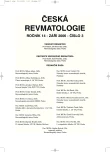Polymyalgia rheumatica and giant cell arteritis, contribution to the treatment, clinical and laboratory examination
Authors:
J. Rovenský 1; H. Tauchmannová 1; V. Štvrtinová 2; S. Štvrtina 2; J. Duda 3
Authors‘ workplace:
Národný ústav reumatických chorôb, Piešťany
1; II. interná klinika, Bratislava
2; Reumatologická ambulancia, Michalovce
3
Published in:
Čes. Revmatol., 14, 2006, No. 3, p. 135-143.
Category:
Case Report
Overview
Polymyalgia rheumatica (PMR) and giant cell arteritis (GCA) are closely related disorders, particularly occurring in the elderly. Both diseases are characterized with high inflammatory activity. Except systemic symptoms, the clinical features include myalgias, pain of shoulder girdle and less frequently also of pelvic girdle. GCA is accompanied by inflammation of vessel walls that originate from the arch of the aorta. Localization of those affections obviously predicts further clinical feature. Etiopathogenesis of both diseases has not been elucidated yet. Certain HLA antigens can associate with the disease and some typical inflammatory pathways of the immune reaction have been discovered. Neuroendocrine changes associated with natural senescence of the organism may also be implicated in the pathogenesis of PMR and GCA in genetically predisposed subjects. Good therapeutical response to glucocorticoids supports the idea that cortisol concentration in the patients with PMR and GCA is lower compared with what could have been expected in the course of longstanding inflammation. The treatment with glucocorticoids is undertaken for relatively long time and the doses used in GCA are substantially higher than in PMR. Examination of the development of osteoporosis, its proper treatment and monitoring are necessary.
Key words:
polymyalgia rheumatica, giant cell arteritis, genetic predisposition, therapeutic guidelines, glucocorticoids, monitoring of side effects
Labels
Dermatology & STDs Paediatric rheumatology RheumatologyArticle was published in
Czech Rheumatology

2006 Issue 3
Most read in this issue
- Affection of temporomandibular joint in rheumatic diseases
- Rheumatic and other manifestations of Campylobacter jejuni infection
- Issue of tuberculosis associated with TNF blocking treatment in the Czech Republic
- Pulmonary manifestations in selected systemic rheumatic diseases registered in the Czech Clinical Database/Registry
